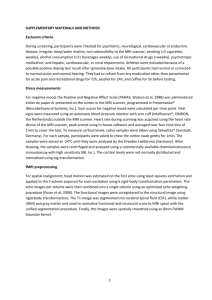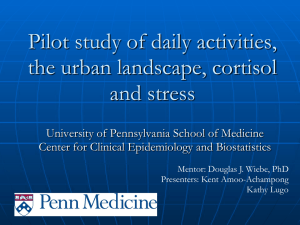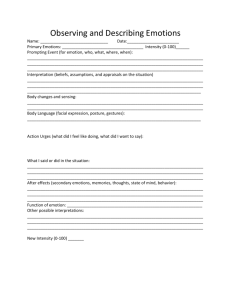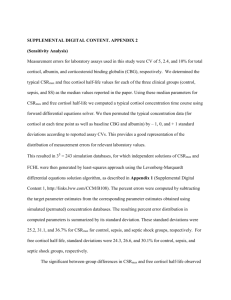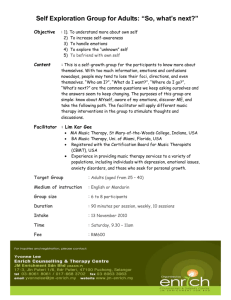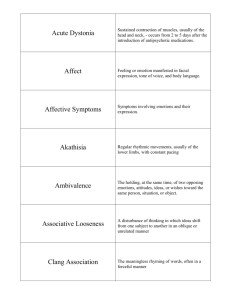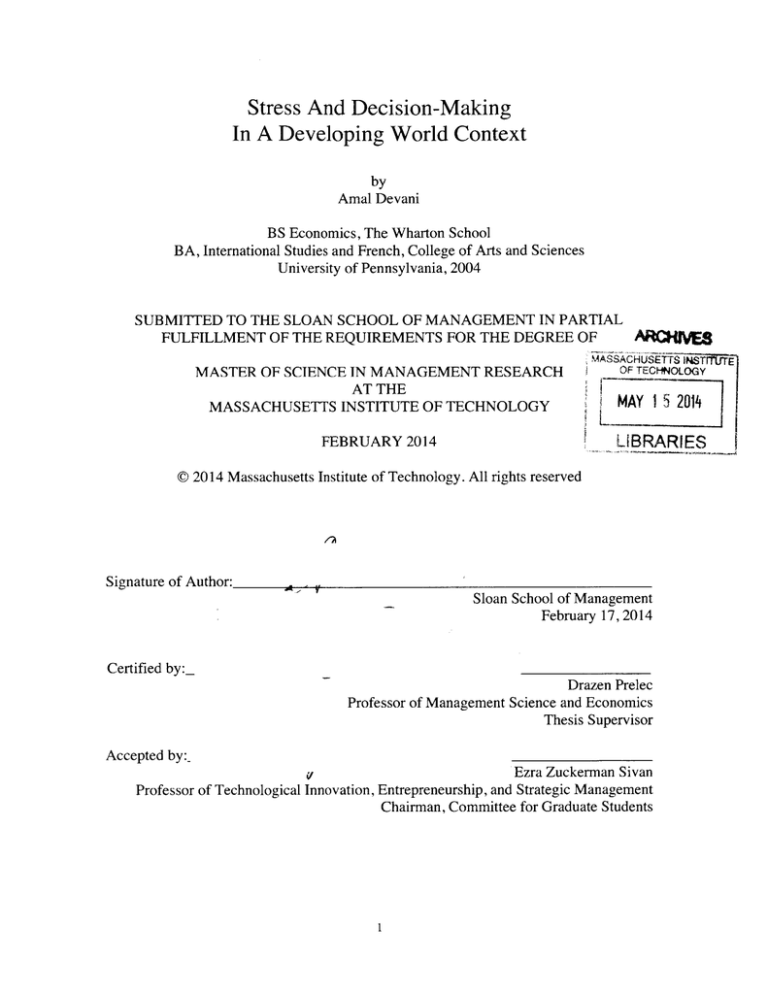
Stress And Decision-Making
In A Developing World Context
by
Amal Devani
BS Economics, The Wharton School
BA, International Studies and French, College of Arts and Sciences
University of Pennsylvania, 2004
SUBMITTED TO THE SLOAN SCHOOL OF MANAGEMENT IN PARTIAL
FULFILLMENT OF THE REQUIREMENTS FOR THE DEGREE OF
ARCtOEM
OF TECHNOLOGY
MASTER OF SCIENCE IN MANAGEMENT RESEARCH
AT THE
MASSACHUSETTS INSTITUTE OF TECHNOLOGY
MAY 15 2014
FEBRUARY 2014
LIBRARIES
©2014 Massachusetts Institute of Technology. All rights reserved
Signature of Author:.
- 11
Sloan School of Management
February 17, 2014
Certified by:
Drazen Prelec
Professor of Management Science and Economics
Thesis Supervisor
Accepted by:Ezra Zuckerman Sivan
Professor of Technological Innovation, Entrepreneurship, and Strategic Management
Chairman, Committee for Graduate Students
I
Stress And Decision-Making
In A Developing World Context
by
Amal Devani
Submitted to the Sloan School of Management on February 17, 2014 in Partial
Fulfillment of the Requirements for the Degree of Master of Science in Management
Research
ABSTRACT
This paper gauges the effect of physiological stress on time preference in the urban poor
from informal settlements in Nairobi, Kenya. Using a standardized psychosocial stress
challenge (the Trier social stress test (TSST)) to induce stress in a randomized setting, we
attempt to estimate the effect of stress on decision making with incentive-compatible
outcomes.
While demonstrating discounting patterns similar to other research in the developed
world, this current study finds some interesting results on the effect of stress on time
preferences, but only in later periods. The study interprets this data and suggests
methodological improvements and further ideas for this promising area of study.
Thesis Supervisor: Drazen Prelec
Title: Professor of Management Science and Economics
3
4
INTRODUCTION
A growing body of research in judgment and decision-making has in recent years
integrated physiology and emotion much more into an area that was previously
considered to be driven by purely rational, cognitive processes. Numerous researchers are
exploring the effect of various emotional states on decision making, as well as the effect
of specific emotions and physiological states (see Lerner and Kelter 2000, 2001 for
discussion and reviews).
Previous research has shown significant linkages between affective states and
normatively unrelated judgments made by an individual (see Forgas and George 2001;
DeSteno et al 2000 and Lerner and Keltner 2000 for reviews). Lerner and Keltner (2001)
have taken a more finely-grained approach, arguing that specific emotions (regardless of
global valence) have differing effects on judgment. For example, while anger and fear are
both negative-valence emotions, they have rather different effects on assessment of risk
(Lerner and Keltner 2001). Lerner and Keltner's (2000, 2001) appraisal tendency
framework attempts to tie emotion-specific appraisal effects to a variety of judgment and
choice outcomes. Their key assumptions include the belief that emotions involve
widespread effects in cognition and physiology and will often endure beyond the initial
cause of the emotion evoked. They posit that these enduring processes will affect
behavior and cognition even in response to unrelated objects and events. A further
assumption is that different emotions have different underlying cognitive dimensions,
despite similarities in valence (Smith and Ellsworth 1985, Lerner and Keltner 2001).
5
Stress, Poverty and Decision Making
Stress, then, as a joint psychological/physiological concept, should have measurable
effects on cognition and decision-making. We can all imagine situations where we have
made decisions or taken actions under stress (or emotions that contain stress), whether it
is running out of time while taking a difficult examination, to giving a speech in public,
or trying decide between necessities when one is short of money. In fact, a significant
corpus of work on the various effects of stress and cognition has been produced over time
(cf. Keinan 1987 for a review). For example, Holsti (1972) analyzed documents penned
by European heads of state in the period prior to World War I and found that some of the
most important decisions were made based on a 'very narrow time perspective' and did
not consider the long-term consequences of different near-term choices. Keinan (1987)
also found that stress brought about deficient decision-making partly because of an
individual's failure to suitably evaluate the relevant alternatives.
More recently, work has been done showing the effects of stress on working memory
(Schoofs et al 2008), performance on gambling tasks (Preston et al 2007), and in a
number of other areas (see Starck and Brand 2012 for a review). Loewenstein (1996,
2000) has demonstrated that strong emotion can often bring about high discounting rates,
1Attempting to clearly, scientifically define specific emotions and any underlying factors remains
an open issue; for the purposes of this paper we are merely allowing that stress has physiological
and psychological/emotional elements, and that stress caused by a mental evaluation has physical
effects and vice versa (see Feldman Barrett and Bliss-Moreau 2009, James 1890)
6
and Kassam et al 2008 show high 'affective discount rates' when predicting their
enjoyment of future monetary payments.
Development economics literature has for a long time linked poverty linked to
present-focused discount rates and preferences, citing a variety of different possible
reasons for this effect. Hausman (1979) found that poor had higher discount rates than
wealthier ones. Several authors posit that the environmental milieu of poverty bring about
direct impact on preferences (e.g. Bertrand et al 2004), while others have shown presentfocused behavior occurs when individuals are calorie-constrained and/or close to
subsistence (Dasgupta 1997). Haushofer and Fehr (2013) and Haushofer et al
(unpublished) have shown that there is a positive relationship between poverty and
physiological measures of stress, but those results still allude to a baseline, habitual stress
level versus specific, episodal incidences.
Understanding how the poor make decisions could be a key tool in the design of
policies and financial products that help prevent or alleviate some of the more avoidable
decision-making traps in the quest for reducing poverty world wide. Studies showing the
connection between various emotional factors and decision making do exist (as
mentioned above), however, very rarely has this affective lens been utilized in the
developing world, where individuals are even more at risk to the repercussions of faulty
or irrational economic or financial decision-making.
The goal of this study is to build on previous research and assess this decisionmaking ability of the developing world poor in the context of stress in a lab setting, and
begin to connect this decision making more directly to measurable physiological factors.
7
We will utilize methodologies proven in the developed world in a novel geographic and
demographic setting in an attempt to replicate these results and better understand the
decision making context of the poor, and perhaps improve their situation.
HYPOTHESES
HI: Participants will demonstrate an increase in self-reported negative emotion after
a stressful event
H2: Stressed participants will have increased physiological effects of stress in line
with previous studies. Specifically:
a) Participants will demonstrate an increase in salivary cortisol relative to
baseline levels
b) Baseline cortisol will be higher in developing world subjects than in
developed world subjects
H3: Stress will lead to an increased preference for current payoffs
METHODS
Participants and Participant Selection
A total of 102 healthy adult male participants were recruited from two slums in Nairobi,
Kenya (mean age 29.8, standard deviation 9.16) and randomly assigned to either the
8
treatment or control group. They were instructed to not smoke or drink alcohol 24 hours
prior to reporting for the study, and arrive on an empty stomach. Only adult male
participants were selected for this study since the hormone cortisol is being tested, and in
females there is the possibility of cortisol release variability over the course of the
menstrual cycle. All sessions were held in the afternoon to minimize possible
confounding from normal diurnal fluctuations in baseline cortisol levels. Finally, all
participants had to own or have access to an 'MPESA' account (the most commonly-used
mobile payment system in Kenya) in order to receive their payments from the study.
Procedures
Overview
After an initial in-person briefing and signing of consent forms, the participants were
seated in visually isolated cubicles in front of a touch screen computer monitor running
zTree (REFERENCE), upon which all tasks (except for the TSST protocol) were run.
Subsequently, tasks were run in the following order:
1.
Introductory tasks
2. PANAS
3. Time preference task
4. TSST or control task (standing)
5. PANAS
6. Time preference task part 2
7. Questionnaire and debriefing
9
Introductory tasks
Participants were given an introduction to the touchscreen and asked to press certain parts
of the screen (virtual buttons) to ascertain comfort and proper functioning. They were
then asked two simple choice questions ("Would you rather receive 40 shillings or 20
shillings now", and "would you rather receive 40 shillings now or 40 shillings in 12
months?"). This was done primarily to create comfort with the kinds of questions that
were to be asked, but also as a check to make sure that participants understood what was
being asked (given the clear dominance of one choice in each question).
At the time of the introductory tasks, the first saliva sample was taken using a
salivette (for future laboratory cortisol testing). Following the TSST, a further 6 saliva
samples were taken (at 0, 20, 30, 50 and 70 minutes after TSST). Total time for the study
ranged between approximately 3 and 4 hours, depending on the speed of task completion.
PANAS
Participants complete an 11-item negative-adapted Positive and Negative Affect Scale
(PANAS) scale (Watson, Clark and Tellegen, 1988) on a touch screen. Response options
ranged from 0 ('not at all') to 100 ('very much'), and were presented on a visual analog
scale (VAS). Responses were summed to give an aggregate score. Options were
presented in English, but the facilitator also used the Swahili translations of the words to
improve clarity and comprehension
10
Time preferences tasks (pre- and post-TSST)
Participants were given a series of incentive-compatible question to gauge their time and
risk preferences. In one task, subjects were asked questions regarding when they would
like to receive various paired amounts of money (i.e. smaller-sooner vs. larger-later). The
choice alternatives take the form {x,t}, where x is a reward to be received t months from
now. In the case of our study, t varied from 0 to 12 months in 3 month intervals:
1.
Now vs. 6 months
2. Now vs. 12 months
3. 6 months vs. 12 months
6 questions were administered in each time block, for at total of 18 questions. In each
case the larger-later amount was Kshs 200 (approximately $2.30), and the smaller-soon
amount began at Kshs 100 (50% of the larger amount) and was adjusted using a titration
method depending on the subjects choices (Mazur, 1988; Green & Myerson, 2004). At
each subsequent question, the smaller-sooner choice halved in value, and gradually
approximated the participants' indifference points at each delay pair, i.e. the amount of
the smaller-sooner choice where participants switched to the larger-later reward. In our
results, we
Participants were paid based on randomly selected instances out of their choices (i.e. if
they selected 200 shillings in 3 months, they will be paid that amount in 3 months via a
mobile phone payment).
11
TSST
The TSST is a reliable protocol used to elicit psychosocial stress in controlled laboratory
settings. Endocrine responses to stress have been well-documented in the literature, and
the TSST builds off this knowledge to safely induce stress in participants through
stressful social interactions. It consists primarily of an anticipation period and a test
period, where subjects have to deliver a free-form statement (or speech) and engage in
mental arithmetic testing in front of other people. The protocol has yielded consistent
results in six independent studies in the developed world, having been shown to yield two
to four-fold increases in salivary cortisol levels relative to pre-test baseline levels, along
with increases in heart rate, ACTH, serum cortisol, growth hormone and prolactin
(Kirschbaum et al 1993, Kelly et al 2008)
In this version of the test, participants were given a mock job interview by a
confederate they had not seen before. Participants were given 5 minutes to prepare a
statement regarding their suitability for a job (note-taking materials were provided) and
were individually told to present their statement and asked difficult questions about their
application in front of the other participants (after materials were removed). During this
time, all participants were standing, and therefore able to see and hear each other. After
the 'job interview', each participant was given a 'maths test', where they were asked to
count backwards in increments of 16 from a large number (e.g. 4560) for a period of one
and a half minutes. Each time an error was made, they were asked to start from the
beginning. Each participant was given a different large number to prevent any
memorization.
12
In the control condition, participants were asked to prepare a statement about a
good friend of theirs, and then told to speak about their friend out loud and
simultaneously with the other participants. In the maths portion, they were asked to count
backwards out loud from a large number in increments of 16. Similarly, this was done
simultaneously with other participants with no monitoring or interference by the study
administrators.
RESULTS
PreliminaryTest
In the preliminary test, of the 102 total initial participants 84 participants (82.3%) chose
to receive 40 shillings today, while 18 (17.6%) chose to receive 40 shillings 12 months
from now. Further, 89 participants (87%) chose to receive 40 today, while 13 participants
(12.7%) elected instead to receive 20 shillings today. 10 participants chose both
suboptimal choices, and it was decided that they be eliminated from the study since their
choices raised questions regarding their understanding of and comfort with the kind of
questions (of the computer-based format) of the study.2
Even this simple test indicates the difficulty faced with conducting studies in the
developing world, where the setting and context of the study is unfamiliar and abstracted
A further 10 subjects were excluded because of a programming error that prevented full data
capture
2
13
from everyday life, even though the participants are ostensibly literate and basically
numerate. This is a point to which we will return in the general discussion.
PANAS
A paired t-test was used to compare the mean PANAS scores within subjects pre- and
post-TSST. A summary of the results appear in Table 1. below:
TABLE 1: SUMMARY OF PANAS SCORES
Pre-TSST (1)
Post-TSST (2)
(1)-(2)
p-value
Mean
267.87
307.06
-33.23
0.3498
SD
188.92
218.48
40
40
Mean
256.79
244.81
11.98
0.6509
SD
196.26
213.08
42
42
Treatment
N
Control
N
The results in both cases do not appear to be statistically significant (p=0.3498
and p=0.6509 respectively). However based on observation, in the case of the treatment
14
group the post-TSST mean is higher by approximately 40 points. These results are at
least directionally as expected, and would suggest further refinements to the experimental
technique might be warranted. For example, a 100-point scale in a situation such as the
one above may be too large and yield an unnecessarily large amount of variation, in
addition to being less intuitive when self-reporting affect as compared to, for example, a
seven-point Likert scale with verbal comparative choice options or a smaller, clearer
VAS scale.
TSST
Total plasma cortisol responses will be analyzed with a repeated-measures analysis of
covariance (ANCOVA). A repeated-measures time factor is included in the analysis.
Since cortisol responses may be affected by age, this factor will also be included as a
covariate. When considered appropriate, the Greenhouse-Geisser degrees of freedom
adjustment will applied to the repeated-measures time factor to correct for violations of
sphericity requirements that frequently occur with repeated-measures analyses. Based on
a number of factors outside the control of the author, the results of the saliva cortisol tests
were not available at the time of the submission of this paper. However, we expect that
these results match the consistent results of the documented administrations of the TSST
(Kirschbaum et al 1993 and Kelly et al 2008)
Time Preferences
In our results, following Prelec (2004), we use indifference points (i.e. the value of Kshs
200 at a particular time point, as seen from an earlier standpoint), as well as the implied
15
annualized discount rate for each indifference point (i.e. between each time-period pair).
This is given by the equation (a re-arrangement of the continuous annualized
compounding formula):
it 1,t2
=
-
12
t2 - 1
t2 - t1
Pi
-P
P2
where i is the implied discount rate for the given period, t, and t 2 are the time periods in
question, and p, and P2 are the smaller-sooner and larger-later payments respectively.
Decreasing impatience and departures from stationarity are calculated in the following
manner:
DI =iO,6-iO,12
DS = iO,6-i6,12
A positive decreasing impatience factor indicates less discounting (on an annualized
basis) over a longer time period (in this case 12 months) versus a shorter time period (6
months). A predicted desire for sooner payoffs in our case would correspond with a
positive DI. A departure from stationarity is a measure for relative discounting between
two more distant future periods versus two nearer-future periods, which is to say that a
positive DS indicates greater discounting (i0 6 > i6, 2 ) in period tO,than in period t6 ,1 2
Tables 2 and 3 below summarizes our findings pre-and post intervention, and is
consistent with previous findings regarding the shape of the discounting curve over time.
16
Interestingly, statistically significant differences are seen in the treatment group's 0 vs.
12 month and 6 vs. 12 month periods, but not in the current period. Discount rates are
also statistically significantly different in the treatment group, as are the indices (DI and
DS)
TABLE 2: SUMMARY STATISTICS FOR TIME DISCOUNTING TASK
Treatment
Control
POST
PRE
POST
PRE
Mean
SD
Mean
SD
Mean
SD
Mean
SD
Now vs. 6 months
36.25
(44.83)
49.84
(57.50)
36.90
(49.09)
49.11
(68.15)
Now vs. 12 months
107.50
(79.10)
100.31
(74.53)
108.48
(73.27)
85.71
(75.26)
6 vs. 12 months
59.22
(53.35)
63.28
(55.27)
67.71
(54.63)
48.66
(47.58)
Now vs. 6 months
4.70
(2.23)
4.16
(2.50)
4.75
(2.25)
4.46
(2.54)
Now vs. 12 months
1.27
(1.46)
1.28
(1.37)
1.10
(1.27)
1.54
(1.41)
6 vs. 12 months
3.57
(2.42)
3.37
(2.35)
3.21
(2.40)
4.07
(2.42)
Decreasing impatience
3.42
(1.72)
2.87
(2.10)
3.65
(2.13)
2.92
(2.26)
Dep. from stationarity
1.13
(2.04)
0.79
(2.50)
1.53
(2.36)
0.38
2.20
Indifference points
Discount rates
Indices
17
TABLE 3: EFFECT OF STRESS ON TIME PREFERENCE
Control
Treatment
Mean
SE
p-value
Mean
SE
p-value
Now vs. 6 months
-13.59
11.53
0.24
-12.20
10.77
0.26
Now vs. 12 months
7.19
17.18
0.68
22.77
10.76
0.04**
6 vs. 12 months
-4.06
12.15
0.74
19.05
6.98
0.009***
Now vs. 6 months
0.54
0.36
0.14
0.29
0.38
0.44
Now vs. 12 months
0.00
0.24
0.97
-0.44
0.20
0.03**
6 vs. 12 months
0.20
0.41
0.62
-0.86
0.28
0.004***
Decreasing impatience
0.55
0.36
0.13
0.73
0.41
0.08*
Dep. from stationarity
0.34
0.48
0.48
1.15
0.44
0.012**
Indifference points
Discount rates
Indices
***p <0.01, ** p <0.05, * p <0.1
DISCUSSION
The goal of this study was to test the effect of stress on time preference in the poor.
While there appear to be no statistically significant differences between the various
measures pre- and post treatment, these occur in the non-immediate time periods (0 vs. 12
months and 6 vs. 12 months) indicating that the stressed subjects did not exhibit
significantly increasing preferences for immediate payoffs, but did when deciding
between longer or more distant periods. Depending on how this is interpreted, it might be
18
consistent with the existing literature on the effects of stress on decision making in the
developed world. However are a number of factors in this context that may cause issues
with the collection of data, which we will discuss subsequently.
In studies of this nature, one must consider of baseline stress levels among the
participants (and the target population in general). Haushofer et al (unpublished) show
that lower-income individuals in a developed country exhibit higher levels of stress than
those that are not, but this needs also to be shown in a developing world context. It is
possible to imagine the closer an individual is to life-threatening circumstances (vs. much
less serious circumstances in a developed country), the greater the general level of stress.
If baseline stress levels are high enough to begin with, then while incremental stress may
also increase cortisol, heart rate and other physiological measures, this does not
automatically translate to changes in time preference in every period (though it may in
some). It is feasible that there is a non-linear relationship between stress levels and time
preference, i.e. there is a critical stress level above which discounting is increased, but
greater stress above this level may not affect time preferences in a period where the
indifference point is very low, but may affect other periods in a consistent fashion.
However, further work should be done to evaluate this idea further.
Experimental issues and recommendations
As we saw from the pretest, there were a number of individuals that selected objectively
poorer outcomes (some on both occasions). This implies that there was either a lack of
understanding of the questions as asked, or discomfort with the experimental setup as it
19
stands, or both. It would appear that both would be major considerations in making valid
decisions, given how divorced from normal life the laboratory setting is at the best of
times. In situations where individuals' life experiences rarely include computers and
these shorts of choices, it is entirely feasible that choices were made in a quasi-random
fashion in order to progress through the study as quickly as possible. One possible
solution would be to contextualize the choices so that parallels can be drawn to the
participants' real-life experiences, and better engages their thought processes. For
example, the questions could be related to receiving payment for work done, or as a gift
from a relative, etc.
Further related study could include more detailed analysis of the pattern, order
and timing of responses of responses within subjects in order to ascertain whether or not
thought and time were being expended while evaluating the options, as well as including
attention tests within the study. It may also be desirable to conduct computer training or
select a more computer-literate group of subjects, as well as more thoroughly explain the
incentives structure for choices during the study (aside from the appearance fee).
There are further aspects of the experimental design that could be altered and
improved in order to elicit better responses. For example, the overall duration of the
experiment was between 3 and 4 hours. With this amount of time spent in the lab, it is
entirely feasible that attention is eroded. In the debrief following the experiment,
participants consistently complained about the duration, citing the need to catch buses,
meet their children, shop for food, etc. A number also complained about not having been
able to eat prior to the experiment, while others were confused regarding structure of
payments.
20
Administration of the PANAS after the TSST may also yield problematic results,
since labeling state emotions reduces their effect on judgment (Keltner, Locke and
Audrain, 1993). In self-reporting their felt negative emotions in the PANAS, the
participants may attribute their negative emotions to the administered TSST, and
therefore regulate those emotions and use different factors when evaluating their affect
(Gross 2002). Thus it may be more beneficial to utilize less obtrusive methods such as
heart rate monitoring or other physiological measures in addition to cortisol.
As suggested by Keinan (1987), stress also results in improper evaluation of the
alternatives on offer, which could further disrupt results particularly in this case (as
mentioned before) where there is a lack of fluency with the format of the questions and
discomfort with the setting. Separately, von Dawans et al (2012) show greater prosocial
behavior under acute stress, which may indicate the possibily of other considerations
besides self that may affect the individual discount curve. The possibility of influencing
group success versus individual may be another avenue to oconsider.
In summary, the results of the current study do not conclusively show the effect of
stress on time preferences of the poor in a developing world setting. Changes to the
experimental format, including more situation-relevant choice questions should be
utilized in order to provide decision making context to participants unfamiliar with
computers and laboratory settings. Doing so will provide greater ecological validity to
any findings. Future studies should consider the baseline levels of stress in the target
population, since existing high levels of stress would obfuscate the impact of stressinducing interventions in the laboratory setting. Further inquiry, it is hoped, will yield
21
results that provide insight into the though processes of the poor, and perhaps help
develop tools and policies that improve their decisions and their quality of life.
22
REFERENCES
Barrett, L. F., & Bliss-Moreau, E. 2009. "Affect as a psychological primitive." Advances
in Experimental Social Psychology, 41, 167-218.
Bertrand, M., Mullainathan, S., & Shafir, E. 2004. "A behavioral-economics view of
poverty". American Economic Review: Papers and Proceedings, 94(2), 419-423.
Dasgupta, P. 1997. "Environmental and resource economics in the world of the poor."
Resources for the Future.
DeSteno, D., Petty, R. E., Wegener, D. T., and Rucker, D. D. 2000. "Beyond valence in
the perception of likelihood: The role of emotion specificity." Journal of Personality and
Social Psychology, 78, 397-416.
Fischbacher, Urs. 2007. "z-Tree: Zurich toolbox for ready-made economic experiments."
Experimental Economics 10 (2): 171-178.
Forgas, J. P., and George, J. M. 2001. "Affective influences on judgments and behavior
in organizations: An information processing perspective." Organizational Behavior and
Human Decision Processes, 86(1) 3-34.
Frederick, S., Loewenstein, G., and O'Donoghue, T. 2003. "Time discounting and time
preference: A critical review". In G. Loewenstein, D. Read, & R. F. Baumeister (Eds.),
Time and decision (pp. 13-86). New York: Russell Sage Foundation.
Green, L., & Myerson, J. 2004. "A discounting framework for choice with delayed and
probabilistic rewards". Psychological Bulletin, 130(5), 769-792.
Gross, J. J. 2002. "Emotion regulation: Affective, cognitive, and social consequences."
Psychophysiology, 39, 281-291
Haushofer, J., Cornelisse, S., Joels, M., Kalenscher, T., and Fehr, E. "Low Income is
Associated with High Baseline Levels and Low Stress Reactivity of Cortisol, but Not
Alpha Amylase." (unpublished working paper)
Haushofer, J., and Fehr, E. 2013. "The psychology and neurobiology of poverty."
Science, forthcoming.
Kassam, K.S.; Gilbert, D.T.; Boston, A.; Wilson, T.D. 2008. "Future anhedonia and time
discounting". Journal of Experimental Social Psychology 44 (6): 1533-1537.
23
Kelly, M.M., Tyrka, A.M., Anderson, G.M., Price, L.H., Carpenter, L.L. 2008. "Sex
differences in emotional and physiological responses to the Trier Social Stress Test."
Journal of Behavioral Therapy & Experimental Psychiat. 39, 87-98
Keltner, D., Locke, K., Audrain, P. 1993. "The influence of attributions on the relevance
of negative feelings to personal satisfaction." Personality and Social Psychology Bulletin,
19(1): 21-29
Kirschbaum, C., Pirke, K. M., & Hellhammer, D. H. 1993. "The "Trier social stress
test" -A tool for investigating psychobiological stress responses in a laboratory setting."
Neuropsychobiology, 28, 76-81.
Laibson, D. 1997. "Golden eggs and hyperbolic discounting". Quarterly Journal of
Economics, 62, 443-477.
Lerner, J. S., and Keltner, D. 2000. "Beyond valence: Toward a model of emotionspecific influences on judgment and choice." Cognition and Emotion, 14 (4): 473-493)
Lerner, J.S., and Keltner, D. 2001. "Fear, Anger and Risk." Journal of Personality and
Social Psychology, 81(1): 146-159
Loewenstein, G. 1996. Out of Control: Visceral Influences on Behavior. Organizational
Behavior and Human Decision Processes, 65(3), 272-292.
Loewenstein, G. 2000. Emotions in Economic Theory and Economic Behavior. The
American Economic Review, 90(2), 426-432.
Mazur, J. E. 1988. "Estimation of indifference points with an adjusting-delay procedure."
Journal of the Experimental Analysis of Behavior, 49(1), 37-47.
Prelec, D. 2004. Decreasing Impatience: A Criterion for Non-stationary Time Preference
and "Hyperbolic" Discounting. Scandinavian Journal of Economics, 106, 511-532.
Preston, SD, TW Buchanan, RB Stansfield, and A Bechara. 2007. "Effects of anticipatory
stress on decision making in a gambling task." Behavioral Neuroscience 121 (2): 257.
Schoofs, D., PreuB, D., and Wolf, O.T. 2008. "Psychosocial stress induces working
memory impairments in an n-back paradigm." Psychoneuroendocrinology 33 (5): 643653.
Smith, C. A., & Ellsworth, P. C. 1985. "Patterns of cognitive appraisal in emotion."
Journal of Personality and Social Psychology, 48 813-838.
Starcke, Katrin, and Matthias Brand. 2012. "Decision making under stress: a selective
review." Neuroscience & Biobehavioral Reviews 36 (4): 1228-1248.
24
Watson, D., Clark, L. A., & Tellegen, A. 1984. "Cross-cultural convergence in the
structure of mood: A Japanese replication and a comparison with U. S. findings." Journal
of Personality and Social Psychology, 47, 127-144.
Watson, D., Clark, L. A., & Tellegen, A. 1988. "Development and validation of brief
measures of positive and negative affect: The PANAS scales". Journal of Personality and
Social Psychology, 54(6), 1063-1070.
von Dawans B, Fischbacher U, Kirschbaum C, Fehr E, Heinrichs M. 2012. "The social
dimension of stress reactivity: acute stress increases prosocial behavior in humans."
Psychological Science. 23(6): 651-60
25

